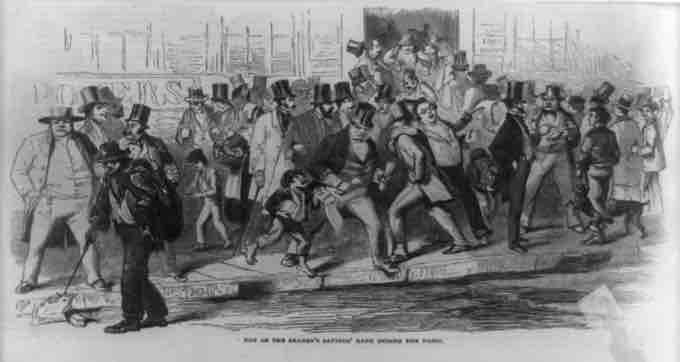Overview
The Panic of 1857 was a financial crisis in the United States caused by an overexpansion of the domestic economy following an international crisis over currency valuation in Britain. It is considered by many to be the first worldwide financial crisis. Beginning in September 1857, the financial downturn lasted until the Civil War. After the failure of Ohio Life Insurance and Trust Company, the Panic quickly spread as businesses failed and the stock market began to plummet. In particular, the railroad industry experienced financial declines and hundreds of workers were laid off, and many banks, merchants, and farmers who had seized the opportunity to take risks with their investments when the market was good experienced widespread financial loss.
Causes
In the early 1850s, westward expansion, development, and investment had resulted in widespread economic prosperity throughout the United States. Railroads and factories began to borrow and invest with generous bank loans. However, by 1857, the value of western land fell and migration drastically slowed. Combined with a falling demand for American goods in Europe, commercial credit was curtailed and many merchants and investors found themselves unable to pay back their debts. Because many banks had financed railroads and the purchase of western lands, they began to feel the pressures of falling railroad securities.
Numerous western railroad companies began to fail—further decreasing the value of railroad securities, stocks, and bonds. The prices of grain also decreased significantly, and farmers experienced a loss in revenue, resulting in many foreclosures on recently purchased lands. For instance, grain prices in 1855 had skyrocketed to $2.19 a bushel, so farmers had begun to purchase land to increase their crop supply (and profits). However, by 1858, grain prices dropped severely to $0.80 a bushel, and as a result, land sales declined and westward expansion essentially halted until the Panic ended.
The Panic of 1857 was set into motion with the failure of Ohio Life Insurance and Trust Company, which had large mortgage holdings and ties to national investment banks. The failure of Ohio Life brought attention to the financial state of the railroad industry and land markets and brought the financial panic to the forefront of public issues. Another event that precipitated the Panic was the Supreme Court's ruling in the Dred Scott case, which opened all western territories to slavery. Soon after the Dred Scott case, it became evident that the ruling would have drastic financial and political effects as railroad securities and land values began to decrease. As a result, many Americans began to view the West as a risky investment where previously they considered it a symbol of prosperity and development.
Results of the Panic
In the aftermath of the Panic, the Southern economy suffered little while the Northern economy made a slow recovery. Urban riots became common in the North and West as laborers and wealthier factions clashed over the financial crisis. Blame for the Panic, however, was leveled at the South, which was seen as responsible for undermining the stability and security of western industrial development by pushing its proslavery agenda. Southerners, however, saw the temporary collapse of Northern industry as validation of the plantation economy and proof that a proslavery society was a superior system to wage labor and continued to push for more political concessions from Congress. As a result, by 1859, tensions between North and South were heightened with agitation coalescing around the slavery issue on both sides.

The Panic of 1857
Bank run on the Seamen's Savings Bank during the Panic of 1857.